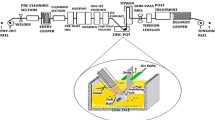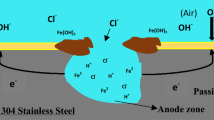Abstract
It is known that the corrosion resistance of stainless steel is deteriorated by blasting, but the reason for this deterioration is not clear. A blasted austenitic stainless steel plate (JIS-SUS304) has been characterized with comparison to the scraped and non-blasted specimens. The surface roughness of the blasted specimen is larger than that of materials finished with #180 paper. A martensite phase is formed in the surface layer of both blasted and scraped specimens. Compressive residual stress is generated in the blasted specimen and the maximum residual stress is formed at 50–100 µm from the surface. The corrosion potentials of the blasted specimen and subsequently solution treated specimen are lower than that of the non-blasted specimen. The passivation current densities of the blasted specimens are higher those of the non-blasted specimen. The blasted specimen and the subsequently solution treated specimen exhibit rust in 5% sodium chloride (NaCl) solution, while the non-blasted specimen and ground specimen do not rust in the solution. It is concluded that the deterioration of corrosion resistance of austenitic stainless steel through blasting is caused by the roughed morphology of the surface.
Similar content being viewed by others
References
Anon.: “Hot Rolled Stainless Steel Plates, Sheets and Strip,” JIS G4304, 1999 (in Japanese).
Anon.: “Methods of Neutral Salt Spray Testing,” JIS Z2371, 1994 (in Japanese).
K. Kon and T. Hisamatsu: “Stress Corrosion Cracking and (100) Faceting Dissolution of Pure Al-Cu Single Crystals,” Boshoku Gijutsu (Corrosion Engineering), 1977, 26, pp. 565–71 (in Japanese).
N. Ohtani: “Stress Corrosion Cracking,” Boshoku Gijutsu (Corrosion Engineering), 1977, 26, pp. 655–61 (in Japanese).
R.B. Mears and R.H. Brown: “Causes of Corrosion Currents,” Ind. Eng. Chem. 1941, 33, pp. 1001–10.
K. Tosha and K. Lida: “Affected Layer Produced by Grit Blasting for Austenitic Stainless Steel,” Int. J. Japan Soc. Prec. Eng., 1995, 29(1), pp. 46–47.
J. Chen, T. Tersaki, T. Akiyama, and K. Kishitake: “Effect of Layer Removal Methods on Residual Stress Estimated by Inherent Strain Method,” Quart. J. Jpn. Weld. Soc., 1996, 14(4), pp. 762–67 (in Japanese).
Anon.: “Test Methods for Abrasion Resistance of Anodic Oxide Coatings on Aluminium and Aluminium Alloys-Part 1: Wheel Wear Test,” JIS H8682-11999 (in Japanese).
T. Tersaki, S. Chen, T. Akiyama, and K. Kishitake: “Non-Destructive Method for Estimating Residual Stress Distribution in Component Due to Shot Peening,” Trans. Jpn. Soc. Mech. Eng., 1998, 64(618), pp. 353–59 (in Japanese).
R. Lagneborg: “The Martensite Transformation in 18% Cr-8% Ni Steels,” Acta Metall., 1964, 12, pp. 823–43.
F. Lecroisey and A. Pineau: “Martensitic Transformations Induced by Plastic Deformation in the Fe-Ni-Cr-C System,” Metall. Trans., 1972, 3, pp. 387–96.
T. Maekawa, N. Nakajima, and M. Kagawa: “Effect of Cold Working on Anodic Behavior of Stainless Steel in Sulfuric Acid Solution,” J. Jpn. Inst. Met., 1965, 29(3), pp. 248–52 (in Japanese).
Author information
Authors and Affiliations
Rights and permissions
About this article
Cite this article
Otsubo, F., Kishitake, K., Akiyama, T. et al. Characterization of blasted austenitic stainless steel and its corrosion resistance. J Therm Spray Tech 12, 555–559 (2003). https://doi.org/10.1361/105996303772082305
Received:
Revised:
Issue Date:
DOI: https://doi.org/10.1361/105996303772082305




